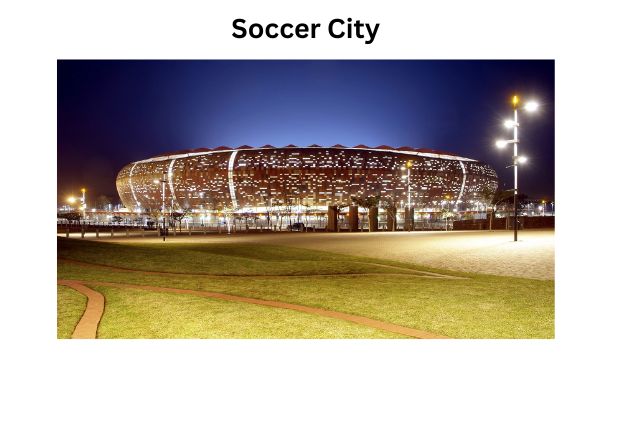Soccer City, also known as FNB Stadium, is a world-renowned sports venue located in Johannesburg, South Africa. It was built between 1986 and 1989 to host the opening and closing ceremonies of the 1990 African Cup of Nations. The stadium has since undergone significant renovations and upgrades, including the addition of a new seating plan, to host the 2010 FIFA World Cup.

The design principles of Soccer City were based on the African pot, a traditional cooking vessel, and the calabash, a gourd used for carrying liquids. The stadium’s unique shape and orange seating plan were designed to reflect the vibrant colors of the South African landscape and the country’s national football team, Bafana Bafana. The construction process was a massive undertaking, requiring 80,000 cubic meters of concrete, 9,000 tons of reinforcing steel, and 8,000 tons of structural steel.
The seating plan of Soccer City was designed to provide an optimal viewing experience for spectators. The stadium has a capacity of 94,736 seats, with most of the seats being orange with only 10 thin black lines. These lines indicate directions to the nine remaining stadiums of the 2010 World Cup and the tenth leads to Berlin, where the previous edition ended. The new seating layout was created by joint forces of Boogertman and Populous, two renowned design offices.
Key Takeaways
- Soccer City’s unique design principles were based on traditional African cooking vessels and the country’s national football team.
- The stadium underwent significant renovations and upgrades to host the 2010 FIFA World Cup.
- The seating plan was designed to provide an optimal viewing experience for spectators, with most of the seats being orange with only 10 thin black lines.
Overview of Soccer City

Soccer City is a stadium located in Johannesburg, South Africa. It is also known as FNB Stadium and was built between 1986 and 1989. The stadium has a seating capacity of 94,736, making it the largest stadium in Africa. It is also one of the most iconic stadiums in the world, having hosted the opening and closing ceremonies of the 2010 FIFA World Cup.
Location and Capacity
Soccer City is located in the Nasrec suburb of Johannesburg, about 5 miles southwest of the city center. The stadium has a total surface area of 87,000 square meters and can accommodate up to 94,736 spectators. It has a two-tier seating bowl, with the upper tier partially covered by a cantilevered roof. The lower tier is completely covered, providing shade and protection from the elements.
Historical Significance
Soccer City has a rich history, having hosted many important events over the years. In addition to the 2010 FIFA World Cup, it has also hosted the 1996 African Cup of Nations, the 2013 African Cup of Nations, and the 2010 FIFA World Cup Final between Spain and the Netherlands. The stadium has also hosted many high-profile concerts, including performances by U2, Coldplay, and the Black Eyed Peas.
Soccer City is a modern stadium with state-of-the-art facilities and amenities. It is a testament to the ingenuity and creativity of its designers and builders, and a source of pride for the people of South Africa.
Design Principles

Architectural Style
Soccer City Stadium was designed by Boogertman + Partners Architects in collaboration with Populous, a global architectural firm. The design was inspired by African pottery and the traditional African calabash, which is a gourd-like container often used for carrying water. The stadium’s exterior is covered in a mosaic of earth-toned panels that resemble the texture of the calabash. The panels are made of a lightweight, weather-resistant material that helps to regulate the temperature inside the stadium.
The stadium’s distinctive shape is a result of its seating arrangement, which is divided into two levels. The lower level consists of a series of concentric rings that are separated by ramps and stairs. The upper level is a continuous ring that wraps around the lower level. The seating arrangement creates an intimate atmosphere that allows fans to feel close to the action on the field.
Sustainability Features
Sustainability was a key consideration in the design and construction of Soccer City Stadium. The stadium’s roof is made of a lightweight, translucent material that allows natural light to penetrate the interior, reducing the need for artificial lighting. The roof also collects rainwater, which is used for irrigation and other non-potable purposes.
The stadium’s ventilation system is designed to take advantage of the prevailing winds in Johannesburg, which help to cool the interior. The system also includes a series of louvers that can be adjusted to control the flow of air.
During the construction of the stadium, a number of measures were taken to minimize the impact on the environment. For example, the excavation of the site was minimized by building the stadium into the existing topography of the land. The stadium’s concrete structure was made with a high percentage of recycled materials, and the construction process was designed to minimize waste and reduce energy consumption.
Construction Process

Soccer City Stadium is a marvel of modern engineering, and its construction process was a complex and challenging undertaking. The construction process can be broken down into three main phases: planning and pre-construction, materials and methods, and challenges and solutions.
Planning and Pre-Construction
Before any construction work could begin, a team of architects and engineers had to create a detailed plan for the stadium. This involved analyzing the site location, determining the optimal seating capacity, and designing the stadium’s unique shape. The planning phase also included securing funding for the project, obtaining necessary permits and approvals, and selecting a construction team.
Materials and Methods
Once the planning phase was complete, the construction team began the process of building the stadium. One of the most significant challenges they faced was finding the right materials and construction methods that could withstand the harsh South African climate. The seats of the stadium, for example, were designed in the UK and manufactured in polycarbonate. The British company that built an office opened in Durban, South Africa, and 95 percent of the components of the seats have been made locally. The grass used in the stadium was a special hybrid of Bermuda and rye grass, which was chosen for its durability and resistance to heat and drought.
Challenges and Solutions
Despite the meticulous planning and preparation, the construction team faced several challenges during the building process. One of the most significant obstacles was the tight construction schedule, which required the team to work around the clock to meet their deadlines. Additionally, the team had to contend with the logistical challenges of transporting materials and equipment to the site, which was located in a remote area of South Africa.
To overcome these challenges, the construction team employed innovative solutions, such as using pre-fabricated building components and implementing lean construction practices. These methods helped to streamline the construction process and ensure that the stadium was completed on time and within budget.
Seating Plan
Soccer City Stadium boasts a seating capacity of 94,700. The seating plan is designed to offer a comfortable and enjoyable viewing experience for all spectators.
Seating Categories
The stadium has four seating categories: Category 1, Category 2, Category 3, and Category 4. Category 1 seats are located in the lower tier, closest to the field, and offer the best view of the action. Category 2 seats are also located in the lower tier but are slightly further back from the field. Category 3 seats are in the upper tier, while Category 4 seats are in the corners of the stadium.
Accessibility and Comfort
Soccer City Stadium is designed to be accessible and comfortable for all spectators. The stadium has ramps and elevators for wheelchair users, and there are designated seating areas for people with disabilities. The seats are designed to be comfortable, and the stadium has ample legroom to ensure that spectators can sit comfortably throughout the match.
Viewing Experience
The seating plan at Soccer City Stadium is designed to offer an excellent viewing experience for all spectators. The stadium has a steep incline, which means that even spectators in the upper tier have a good view of the action. The seats are also designed to be as close to the field as possible, ensuring that spectators feel like they are part of the action. Overall, the seating plan at Soccer City Stadium is designed to make sure that all spectators have an enjoyable and memorable experience.
Amenities and Facilities
Soccer City Stadium is a world-class facility that offers a wide range of amenities and facilities to enhance the spectator experience. The stadium has a seating capacity of 94,700 and features a unique design that creates an intimate atmosphere for spectators.
Restrooms and Concessions
Soccer City Stadium has ample restrooms and concessions located throughout the facility. The restrooms are well-maintained and easily accessible from all seating sections. The concessions offer a variety of food and drink options, including traditional South African cuisine.
VIP Areas and Lounges
Soccer City Stadium offers several VIP areas and lounges for guests who want to enjoy a more exclusive experience. The VIP areas include private boxes that offer a great view of the field, as well as access to a VIP lounge. The lounge features comfortable seating, a bar, and a variety of food options.
Medical and Security Services
Soccer City Stadium takes the safety and security of its guests seriously. The stadium has a medical center staffed with trained medical personnel to provide first aid and emergency medical care if needed. The stadium also has a comprehensive security system that includes surveillance cameras and trained security personnel to ensure the safety of all guests.
Overall, Soccer City Stadium is a world-class facility that offers a wide range of amenities and facilities to enhance the spectator experience. Whether you are a casual fan or a die-hard supporter, Soccer City Stadium has something for everyone.
Technology Integration
Soccer City Stadium is known for its state-of-the-art technology integration. The stadium is equipped with the latest technology to enhance the fan experience and ensure smooth operations during events. The following subsections highlight some of the key technology features of the stadium.
Scoreboards and Displays
Soccer City Stadium boasts multiple high-definition scoreboards and displays strategically placed throughout the stadium. The main scoreboard, located in the center of the stadium, is a 60-meter-wide LED screen that displays live game scores, replays, and advertisements. Additionally, there are over 200 smaller LED displays located throughout the stadium, providing fans with real-time game statistics and other relevant information.
Sound System
The stadium’s sound system is designed to provide high-quality audio throughout the stadium, ensuring an immersive experience for fans. The system includes over 200 speakers, strategically placed to provide even sound coverage. The sound quality is further enhanced by acoustic treatment in the stadium to reduce echo and improve clarity.
Connectivity Solutions
Soccer City Stadium provides fans with seamless connectivity solutions, ensuring that they can stay connected throughout the game. The stadium is equipped with Wi-Fi and cellular connectivity, enabling fans to access the internet and social media platforms. Additionally, the stadium has charging stations located throughout the stadium, ensuring that fans can keep their devices charged during the game.
In conclusion, Soccer City Stadium’s technology integration is one of the key features that make it a world-class stadium. The stadium’s scoreboards and displays, sound system, and connectivity solutions are designed to enhance the fan experience and ensure smooth operations during events.
Also check: Construction and Seating Plan: Inside Huntersfield Stadium
Regulations and Compliance
Safety Standards
Construction of Soccer City Stadium had to comply with strict safety standards to ensure the safety of spectators. FIFA regulations require that all stadiums have a minimum number of seats, which should be arranged in a way that ensures the safety of spectators. The stadium’s design and construction had to adhere to safety standards set by the South African National Standards (SANS) and the International Building Code (IBC). The seating plan and access to the stadium had to be designed in a way that ensures the safe movement of spectators during events.
Building Codes
The construction of Soccer City Stadium had to comply with local building codes and regulations. The stadium was built to comply with the South African National Building Regulations (SANS 10400) and the National Building Regulations and Building Standards Act of 1977. The stadium had to adhere to strict regulations regarding fire safety, structural stability, and accessibility. The stadium’s design had to incorporate features such as smoke detectors, fire alarms, and emergency exits to ensure the safety of spectators.
Event Regulations
Soccer City Stadium has to comply with event regulations set by FIFA and the South African government. These regulations cover various aspects of event management, including security, ticketing, and crowd control. The stadium must have adequate security measures in place to prevent incidents such as hooliganism and terrorism. The stadium must also comply with regulations regarding the sale and distribution of tickets, including measures to prevent counterfeiting. The stadium’s seating plan and access must be designed in a way that ensures the safe movement of spectators during events.
In summary, the construction and seating plan of Soccer City Stadium had to comply with various regulations and safety standards to ensure the safety of spectators. The stadium had to adhere to building codes and regulations set by the South African government, as well as event regulations set by FIFA.
Maintenance and Upkeep
Maintaining a stadium is an ongoing process that requires regular attention. Soccer City Stadium is no exception. The management team responsible for the stadium’s upkeep ensures that the facility is always in top condition for events and visitors. The stadium’s maintenance team is made up of skilled professionals who are responsible for keeping the stadium clean, safe, and comfortable for visitors.
One of the most important aspects of maintaining a stadium is ensuring that the seating is in good condition. Soccer City Stadium has a seating capacity of 94,700, and the seats are made of durable materials that can withstand heavy use. The stadium’s management team ensures that the seats are regularly cleaned and inspected for damage. Any damaged seats are promptly repaired or replaced to ensure the safety and comfort of visitors.
In addition to the seating, the stadium’s management team also takes care of the facility’s lighting, plumbing, and electrical systems. These systems are essential for the stadium’s operation and must be maintained regularly to ensure that they are functioning properly. The management team works closely with contractors and service providers to ensure that these systems are properly maintained and repaired as needed.
Overall, the maintenance and upkeep of Soccer City Stadium is a complex and ongoing process that requires the expertise of skilled professionals. The management team responsible for the stadium’s upkeep takes this responsibility seriously and works diligently to ensure that the facility is always in top condition for visitors and events.
Frequently Asked Questions
What is the seating capacity of Soccer City?
Soccer City Stadium, also known as FNB Stadium, has a seating capacity of 94,700. This makes it the largest stadium in Africa and the fifth-largest association football stadium in the world.
How was the structural design of Soccer City conceived?
The structural design of Soccer City was inspired by the African pottery tradition. The stadium’s unique shape is meant to resemble an African calabash, a traditional African pot. The design was a collaboration between the South African architectural firms Boogertman Urban Edge & Partners and Populous, a global sports architecture firm.
What were the construction costs for Soccer City?
The construction cost for Soccer City was approximately US$440 million. The stadium underwent a major upgrade in preparation for the 2010 FIFA World Cup, which was hosted by South Africa.
What is the distinctive shape of Soccer City stadium?
The distinctive shape of Soccer City stadium is meant to resemble an African calabash, a traditional African pot. The stadium’s undulating shape and bright orange colour make it a unique landmark in Johannesburg.
Which materials were primarily used in the construction of Soccer City?
The primary materials used in the construction of Soccer City were concrete, steel, and glass. The stadium’s exterior is clad in an outer layer of fibreglass-reinforced concrete panels, which were cast in a mould to create the undulating shape of the stadium.
Are there any downloadable resources detailing Soccer City’s construction and design?
Yes, there are several downloadable resources available online that detail the construction and design of Soccer City. One such resource is the Soccer City Stadium: A Construction and Operations Handbook, which provides a comprehensive overview of the stadium’s construction and design.



